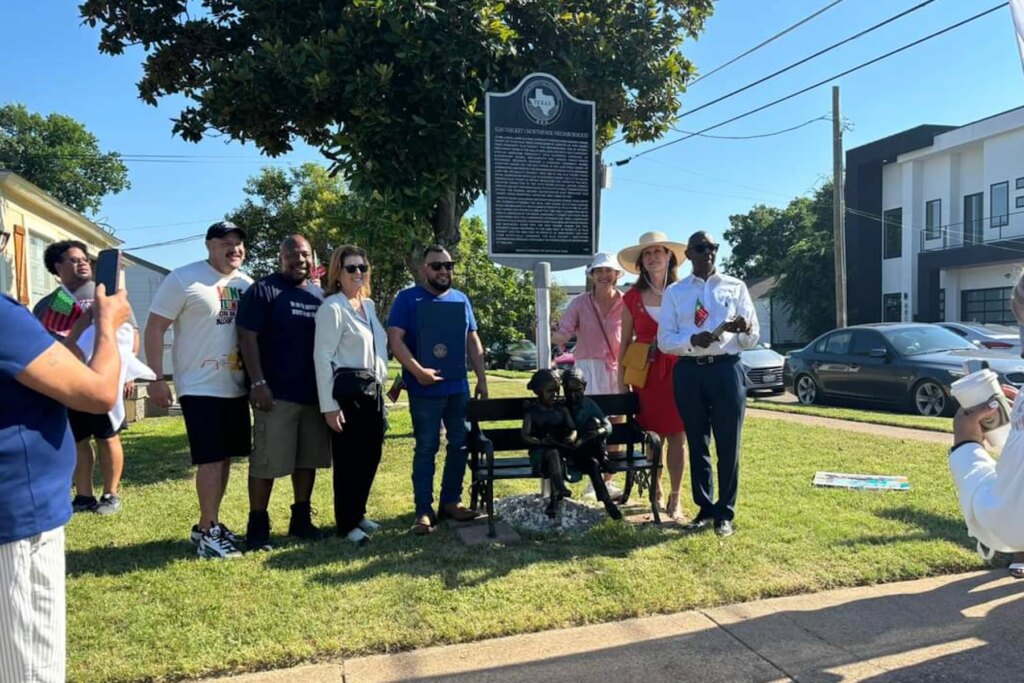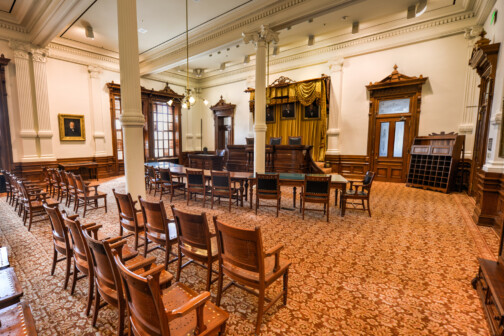Nothing about the historical marker dedication Saturday in the Elm Thicket/Northpark neighborhood occurred by happenstance, except perhaps the sunny June weather that finally replaced a succession of rainy weekends.
On Saturday morning, the marker was covered with a thick cloth at the corner of Thedford and Lockheed avenues, in front of a house. Organizers could’ve found an appropriate home in any number of locations; the obvious choice would’ve been the block that contains K.B. Polk Center for Academically Talented and Gifted, a popular sprayground, and (eventually) a community garden for growing fresh fruit and vegetables.
Instead, the community decided to place it adjacent to the oldest surviving house in the neighborhood. Elm Thicket/NorthPark Neighborhood Association president Jonathan Maples told those gathered for the dedication that the structure was built in 1945. The 521-acre northwest Dallas neighborhood is bounded by Lemmon Avenue, Inwood Road, Lovers Lane, and Mockingbird Lane, near Dallas-Love Field Airport. It was first established as a Freedman’s town.
The neighborhood was redlined in the 1930s, making it nearly impossible for residents to obtain a mortgage. It had thrived. Newspaper articles from the 1920s describe a neighborhood full of “small-but-modest” houses, with a resort, a baseball field, and the largest barbecue restaurant in Dallas at the time — Eltee O. Dave’s BBQ. It was also home to the Hilliard Memorial Golf Park, a golf course for Black Dallasites.
The postwar expansion of Love Field and the relocation of Lemmon Avenue chipped away at the neighborhood in the early 1950s. More recently, developers in search of less expensive land near the city center began buying up lots, tearing down homes, and erecting larger, modern homes in their place. Today, the neighborhood’s proximity to shopping, dining, highways, and the airport makes it one of the most attractive in all of Dallas. Elm Thicket most recently attracted headlines because of a bitter rezoning battle that lasted for nearly a decade.
All of this is history explains why placing the marker in front of the neighborhood’s oldest house is such a statement. Maples said the community didn’t want to place it on city property.
“We would be beholden to the city,” he said. “History is important to me. This marker is one piece of our history. This is where it starts. We are the answers to the prayers of our ancestors.”
After a prayer, the crowd sang, “Lift Every Voice and Sing.” Upon the line, “Let it resound loud as the rolling sea,” the voices dissolved into a chorus of “awww” as the cloth covering was lifted to reveal not just a plaque, but a sculpture of a small bench with two Black children sitting on it, reading a book.

Monday morning, Maples said that he and his fellow neighborhood association officers, Kimberly Sims and Kemeshia Gardner Richardson, also wanted to make a statement with the marker.
“We wanted it to be bigger than life. We wanted it to tell a story because Elm Thicket, like so many other historically Black neighborhoods, is where Black and Brown people were told we could live,” he said. “We couldn’t just go live anywhere.”
The book in the laps of the children, he says, represents how education “was something that was discouraged as it relates to Black folks.” He hopes that the statue helps families and new neighbors understand the history of the neighborhood. The association wants people to seek out the marker and sculpture, take photos with it, and let their children sit next to the two who are frozen in time. It represents the community’s past, present, and future. (According to the Dallas Central Appraisal District, the home is owned by Richardson, the association’s treasurer.)

The marker’s dedication, Maples said, wasn’t just an acknowledgement of the neighborhood’s history. It is also a reference to the hard-fought victory legacy residents won in 2022 after a contentious seven-year battle to stem the tide of encroaching new construction that overwhelmed the remaining midcentury cottages and bungalows. New construction is still allowed, but there are now guardrails that longtime residents and city officials hope will ensure that any new homes are more in scale with the neighborhood’s character.
“This is our historic way of legacy residents planting our flag,” Maples said. “We want people and future generations to know we were here, because Dallas does not protect historically Black and Brown neighborhoods from colonization.”
It is the only historical marker in the neighborhood—so far. Maples said that a marker representing the location of Hilliard Golf Course will come next year.
Author






